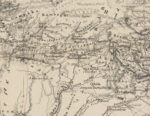 Researchers have discovered that an ancient Indian manuscript is far older than previously realized and therefore contains the earliest known example of the symbol for zero as it is used today. The Bakhshali manuscript, written on 70 delicate leaves of birch bark, was discovered buried in a field near Peshawar in 1881. Indologist AFR Hoernle bought it from the farmer who found it and in
Researchers have discovered that an ancient Indian manuscript is far older than previously realized and therefore contains the earliest known example of the symbol for zero as it is used today. The Bakhshali manuscript, written on 70 delicate leaves of birch bark, was discovered buried in a field near Peshawar in 1881. Indologist AFR Hoernle bought it from the farmer who found it and in  1902 gifted it to the Bodleian Library at the University of Oxford where it is kept in the rare books collection.
1902 gifted it to the Bodleian Library at the University of Oxford where it is kept in the rare books collection.
Replete with Sanskrit numerals, including many instances of the small dot that is the ancestor of our zero, the manuscript is believed to have been written by Silk Road merchants practicing math rather than being a philosophical or scholarly work. Its age has long been subject to debate among scholars and the best guesses, based on factors like writing style and the mathematical concepts it convers, put it between the 8th and 12th century.
 University researchers hoped radiocarbon testing would provide an absolute date and answer some of these long-standing questions. They were astounded when several of the pages turned out to date between 200 and 400 A.D. Before now, the zero dot on the wall of the Ganesh temple at the 9th century Gwalior Fort in Madhya Pradesh, India, was believed to be the oldest visual representation of the ancestor of the modern zero numeral. Researchers expected the Bakshali manuscript to date to around the same time as the depiction in the temple.
University researchers hoped radiocarbon testing would provide an absolute date and answer some of these long-standing questions. They were astounded when several of the pages turned out to date between 200 and 400 A.D. Before now, the zero dot on the wall of the Ganesh temple at the 9th century Gwalior Fort in Madhya Pradesh, India, was believed to be the oldest visual representation of the ancestor of the modern zero numeral. Researchers expected the Bakshali manuscript to date to around the same time as the depiction in the temple.
The zero symbol that we use today evolved from a dot that was used in ancient India and can be seen throughout the Bakhshali manuscript. The dot was originally used as a ‘placeholder’, meaning it was used to indicate orders of magnitude in a number system – for example, denoting 10s, 100s and 1000s.
While the use of zero as a placeholder was seen in several different ancient cultures, such as among the ancient Mayans and Babylonians, the symbol in the Bakhshali manuscript is particularly significant for two reasons. Firstly, it is this dot that evolved to have a hollow centre and became the symbol that we use as zero today. Secondly, it was only in India that this zero developed into a number in its own right, hence creating the concept and the number zero that we understand today – this happened in 628 AD, just a few centuries after the Bakhshali manuscript was produced, when the Indian astronomer and mathematician Brahmagupta wrote a text called Brahmasphutasiddhanta, which is the first document to discuss zero as a number.
The reason for the confusion about its date is that the birch pages date to three different periods, hence the range of styles and arithmetic.
Marcus du Sautoy, Professor of Mathematics at the University of Oxford, said:
‘Today we take it for granted that the concept of zero is used across the globe and is a key building block of the digital world. But the creation of zero as a number in its own right, which evolved from the placeholder dot symbol found in the Bakhshali manuscript, was one of the greatest breakthroughs in the history of mathematics.
‘We now know that it was as early as the 3rd century that mathematicians in India planted the seed of the idea that would later become so fundamental to the modern world. The findings show how vibrant mathematics have been in the Indian sub-continent for centuries.’
The Bodleian will loan one folio from the Bakhshali manuscript to the Science Museum in London for its upcoming Illuminating India: 5000 Years of Science and Innovation exhibition. This is the first time any part of the manuscript has been loaned to another institution and a unique opportunity to see a seminal piece of mathematical history alongside other important of India’s contributions to the history of math, science and technology. It runs from October 4th, 2017, through March 31st, 2018.
It’s really time we all started referring to Hindu Numerals rather than Arabic Numerals, don’t you think?
@dearieme:
The math world is ahead of you. What many call the Arabic Numeral System is actually the Hindu-Arabic Numeral System!
Pssst–your “share” button doesn’t actually share anything, it just links you to addtoany.com.
I can imagine how that happened…
Brahmagupta: “I’ve just invented the zero!”
Surprised Bystander: “What!?”
Brahmagupta: “Oh, nothing.”
Zero. See me!
😆